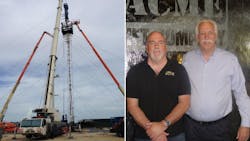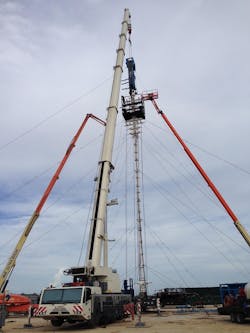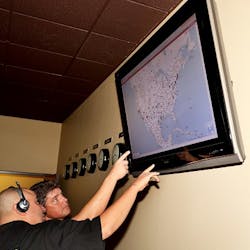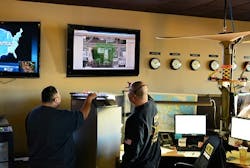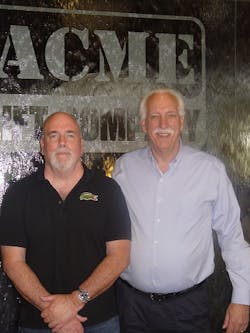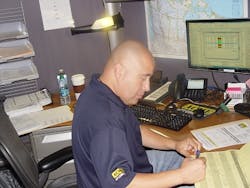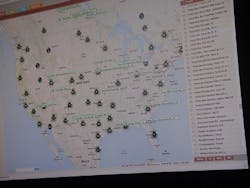What do hundreds of rental companies from the top 10 to Caterpillar dealers to small independents have in common? When they need to rent a 150- or 180-foot boomlift, or a large telehandler, they call Acme Lift.
From Alaska to Arizona, Minnesota to Miami and all points in between, the Acme Lift aerials are at work, decaled as though they belong to the company that rented them from Acme. Every one of them is tracked 24/7/365 by an efficient and omnipresent telematics system. And so the rental company with no yard, and fewer than a handful of mechanics and salesmen, has almost 80 percent of a fleet of nearly 600 boomlifts out on rent.
How it does it is the vision of one of the rental industry’s most charismatic owners, Woody Weld, and the hard-working staff of an operations center called “the war room.” Acme Lift’s operations are strictly wholesale. It only rents to rental companies, not to the end user. It rents the largest boomlifts and telehandlers, the ones most rental companies generally don’t carry in their inventory but prefer to re-rent on a job-by-job basis. Acme Lift refuses to compromise on its business model – it will not rent to the end user and compete with its rental company customers for jobs.
The end user never needs to know the machine is owned by Acme Lift. As far as the end user knows, the machine is coming from the rental company that is Acme’s customer. The machine is probably delivered by the rental company customer, picked up off rent by that company, and maintained by it as well. The rental company might have a few 135-, 150-, 180- or 185-foot boomlifts in its own inventory, or, more often than not, does not. But in order to be a one-stop shop and handle all the needs for the customer, the rental company needs to handle the order and take care of the customers’ needs – and that’s where Acme Lift comes in. As far as the job goes, Acme Lift tends to be invisible and that’s how it likes it. “We’re Switzerland,” says Weld.
The war room fishbowl
The rental transaction begins in the war room, the nerve center of Acme Lift, which handles incoming calls, arrangements for rentals, pickups and deliveries, insurance, the monitoring of equipment and virtually all activity related to the logistics of rental. “The principle of the war room, created by Woody, is that in the old AED model, you had parts in one area of a building, service in another, rentals out there and sales somewhere else and they were all disconnected,” says JP Patterson, vice president of sales and marketing for Acme Lift. “So the communication between those different departments wasn’t really good. But because we had so many assets and we rely on so few people to control those assets, Woody’s idea was to create a fishbowl, or a war-room style concept, an open-operation style so we could all share operation in real time. On one side of the room we have sales and on the other side we have product support and compliance.”
So if a call comes in looking for a 135-foot aerial work platform in Southern California, the war room staff will go to its operational software, enter in that asset and find out where the nearest one is.
Since Acme Lift doesn’t deliver to jobsites, the war room staff will suggest the customer do an on-rent inspection of the unit. The rental company customer decals the machine with its own identity, not that of Acme. The machine will be brought to the jobsite by either the customer renting from Acme, the previous customer that used the machine, or a third party transport firm. The delivery of the unit is negotiated just like every other aspect of the rental contract.
“If the machine requires transport, we have different options,” says Patterson. “Either the customer can elect to ship it, or we can hire a third party, or we can arrange the transportation. Manny [Benites, logistics coordinator] arranges the transportation, gets all the necessary paperwork done on transporting a unit, notifying the customer on a daily basis as to where the unit is en route, making sure it shows up in the condition we said it would show up in and really takes the transport from cradle to grave until it goes on rental.”
When a job is finished, the machine might stay at the rental customer’s yard until the machine is newly rented again. An off-rent inspection is performed as well as an on-rent inspection when the machine is about to be used on a new job by a different customer. The war room is managed by Gabe Benites, Manny’s brother. Tyler Bohnsack, the company’s telemetrics coordinator, creates geofences around each unit on rent, and receives the notifications if a machine is moved. Daxton Tardif calls for followup, arranges customer service and parts when required. Patty Smith handles billing, Steve Carlin customer service, and Diana Chavez deals with licensing, regulatory agencies such as CARB when required and other areas.
Working closely with the war room are the sales staff, which essentially consists of Weld, chief operating officer Michael Crouch and vice president of sales and marketing JP Patterson.
Acme Rents has no yard, although it has a couple of “laydown yards” where machines can be stored when not in use. Often when units come off rent they remain at the facility of the rental customer that rented them last.
If several machines in a particular area are lying dormant with no immediate customer for them, a group of staffers known as AROC – Acme Rental Online Concierge – will proactively contact rental companies in the surrounding region to see if they have jobs coming up that would require the use of large aerial work platforms.
Telemetrics sees all
The key to all of Acme Lift’s operations is its extensive telemetrics – often called telematics in the rental industry, but telemetrics in Acme’s parlance. Acme Lift’s war-room staff knows the exact whereabouts of every machine Acme Lift owns. Geofences are created around every machine and Acme Lift staff is informed via e-mail every time each machine is moved. The Acme Lift staff carefully monitors usage on each unit. Thus all hours are precisely documented and monitored for billing purposes as well as enabling the Acme Lift staff to keep track of service and maintenance intervals.
Many of Acme Lift’s machines go through their entire lifecycle without ever being touched by the Acme staff, yet the company is aware of their every move and monitors their condition on a 24/7/365 basis. By being able to constantly monitor hours of usage, Acme Lift staff always know when a machine reaches required service intervals.
Being able to track the physical location of a machine at all times helps customers not only be aware of possible theft or unauthorized usage of the machine, but helps to track it on jobsites. It is common for the service staff of a rental company to go to a jobsite to service a machine and not be able to find it. The Acme Lift staff regularly informs the service personnel of its customers where to look for the machine on a jobsite. The telemetrics system also helps its rental company customers mitigate potential conflicts with end users in advance.
“It’s an excellent tool for us to supply our customers because often a piece of equipment will arrive at a yard or is delivered to a jobsite and their customer will call them and tell them, ‘It got here and never really worked, we forgot to call it off rent.’ ” says Patterson. “Well, we pull the hours of operation on the asset and supply that to our customers. It’s just data, it’s not confrontational; it shows that the unit was in fact being used. They in turn supply that to their customers. We provide that as a service or a tool for them to use and make them aware.”
“The telemetrics system eliminates arguments,” adds Rick Jewell, vice president of treasury, risk and human resources. “Here’s the documentation; we provide that to the customers. That allows them to go to the end user and say, ‘This is the tracking mechanism that says this machine is being used over the weekend.’ So it becomes a benefit if the customer chooses to go out and use that. It’s just providing the services that allow them to maximize their opportunities with their end users as well as manage their assets.”
The war room staff also monitors the location of its units to make sure they are not used in environmentally harmful applications that damage equipment such as potash mines or shipyards where machines are corroded by salt. Often the customer does not realize where the machine is going to be used. By monitoring the location of the job, the Acme Lift can make the customer aware as well as the end user and make sure they are prepared for the cost of possible damages.
Acme's origins
Acme Lift is, essentially, the brain child of Weld, who co-founded the company in the late 1990s with Rob Ryan, then the rental manager for ACM Equipment and Harry Baker, owner of Southwest Industrial Rigging, who provided start-up capital. Weld came up with the idea while coordinating the rental activities of ACM Equipment [which later evolved into H&E Equipment Services] in Phoenix. Weld was handling the rentals on several major projects, essentially providing all rental needs for the end users. The contractor was renting some 120-foot lifts from ACM and needed more.
Weld requested company ownership buy more, but it refused, saying it would then be stuck with those extra units when the job terminated and was not convinced sufficient demand would exist. Weld, not wanting to let competitive rental companies establish footholds on the project by providing the large lifts, then began to look for opportunities to re-rent the large aerial work platforms but couldn’t find them. It occurred to Weld that a significant niche in the rental market was not being provided and that a company that specialized in re-rental of large aerials could be profitable.
“I went looking, trying to find more 120s for ACM, but I couldn’t find them,” Weld says. “They were nowhere. We [ACM] had all brand-new equipment, I couldn’t have used 20-year-old machines from somewhere, I had to have late-model good stuff. I started thinking, since I couldn’t find them anywhere, that maybe it was time for that to exist.”
At that time, before national rental companies such as United Rentals came on the scene, aerial manufacturers tended not to sell AWPs direct to rental companies, preferring to sell through dealerships. Acme was able to get started by buying some large AWPs from Grove in late 1996 and early 1997, and began working out of Baker’s yard.
“From the beginning, we absolutely refused to do business with end users,” says Weld. “We started by re-renting to rental companies.”
The beginning of the company was somewhat rocky. Ryan quit ACM and came to work for Acme, while Weld stayed with ACM, eventually leaving to work for Mardian Equipment in Phoenix. Weld had made a promise to Baker that if things got tough, he would quit whatever he was doing to work fulltime for Acme. After Ryan left for another opportunity, Weld made good on his promise and began to run Acme in 1999.
At that time, JLG had a program called Equipment Services, which essentially was a rent-to-own fleet. However, the manufacturer’s involvement in the rental business created difficulties in its relationships with rental companies. Weld reached an agreement with JLG to become a kind of re-rental conduit and Acme Lift became a vital player in the re-rental of large aerial work platforms.
“I said ‘Why don’t you transfer that over to me?’ ” says Weld. “I’ll put it in Acme. So JLG started helping to fund me with new equipment. They started getting out of their re-rental fleet and I became kind of their re-rental channel. They never owned any part of Acme, they just helped me get the funding, and that’s kind of how we became so strong with JLG. So many people discovered their big booms through us that Tim Morris used to say that we sold 25 big booms for them for every one we bought ourselves.”
During the 2008-2009 recession, when times were challenging for everybody in the aerial business, JLG essentially was unable to continue its unique relationship with Acme and the company re-capitalized with similar arrangements as most of the larger rental companies. While still carrying a lot of JLG equipment, Acme also carries a large quantity of Genie units in its current fleet.
Streamlined structure
In the past couple of years, Acme Lift reorganized its internal structure with the help of current president and chief operating officer Michael Crouch, a rental industry veteran who got into the equipment rental industry because he was a skilled softball player. A former 9th-grade algebra teacher, Crouch, laid off because of funding cuts in the state of Washington, got a job in a tire store.
“I was working seven days a week, and playing on a softball team,” recalls Crouch. “The third baseman was the branch manager of Hertz Equipment Rental. I was working weekends so I couldn’t make it to tournaments. He said, ‘Hey come to work for me, I’ll teach you the rental business, and you can have weekends off so you can play softball.’ So the reason I got into the rental business was so I could have time to play softball and I’ve been in it ever since.”
Crouch worked for HERC, then U.S. Rentals, then back to HERC, then back to U.S. Rentals, and on to United Rentals when it acquired U.S. Then Crouch ran Volvo Rents Europe for three years and came back to the United States to run its franchise network. When Volvo got out of the franchise business, Crouch worked on the business development side, leading the acquisition of the former franchises. Shortly after Volvo Rents was acquired by Platinum Equity, Crouch joined Acme Lift.
Though brought in to help organize and streamline operations as president, Crouch kept a low profile at first so he could learn the Acme Lift business, which was very different from the rental companies he’d worked for before that rented to the end user. Crouch spent the first month working in the war room and learning the way Acme operated. After that time, rather than dictate changes, Crouch asked war room personnel how they thought they could work more efficiently and found that their thoughts and suggestions closely paralleled his observations.
“I didn’t want to be the new president coming in and making changes,” says Crouch. “I worked really hard at understanding everybody’s job, and identifying what they do piece by piece.”
Crouch and the war room staff worked at a more streamlined efficiency, with each war room worker specializing more clearly in a specific area, rather than the previous tendency to overlap.
“Because everybody was reacting, sometimes people would react twice and sometimes nothing would happen because they thought somebody else was handling it,” says Crouch. “Now we have distinct roles and reporting and we tied a bonus program into it so we have all their individual goals by quarter. The goals were put into place so they would make Acme a much better company and give them an opportunity to take some money home.”
As Crouch says, he still has teaching in his blood, so he’s been able to explain to people concepts such as EBITDA. He also has worked at communicating what is expected of people, helping them concentrate and focus more efficiently.
Crouch also worked closely with Weld on identifying what assets really were making money and which weren’t.
“We’re really concentrating on the bigger space, the 150s, and 180s, because I think that’s where the real profit for us is,” says Crouch. “The previous administration bought a lot of 60-foot AWPs, used units. They’ve become a commodity; everyone’s got them pretty much. To move them from Houston to Iowa, it’s just not profitable for the rental rates. So we identified what’s making us money and it’s made all the difference in the world.
“Because we’re getting a lot more efficient, we’ve got 75 percent of our fleet on rent pretty consistently right now, we’re pushing towards 80. The average fleet was over 57 months when I got here. We’re under 50 now, pushing to be closer to 40. It keeps repair and maintenance down, customers like the newer units more. You put a 10-year-old boom out on a re-rent and people don’t take care of it. Put a brand new 180 out, with all the training on it, they tend to take care of it a little better.”
The company has also worked hard at matching specs to regions.
“A lot of stuff we had up in Alberta, for example, had come from like Florida and we patched up some specs,” says Crouch. “Now they come direct from the factory with the correct seals and correct engine heaters and all those kinds of things. We’re matching the equipment to the regions.”
Weld says the company is in growth mode. It is adding more fleet and will continue to do so, in general focusing on boomlifts 135-feet and higher as well as large telehandlers that most rental companies don’t regularly rent.
Weld is also developing multi-generational leadership.
“We’ve got older guys like Mike and myself with a lot of experience,” says Weld. “We also have the 40-plus generation, guys like JP, who are the next generation of leaders, and we have people in their 20s with a lot of new ideas. So we’re in good shape for the future.”
About the Author
Michael Roth
Editor
Michael Roth has covered the equipment rental industry full time for RER since 1989 and has served as the magazine’s editor in chief since 1994. He has nearly 30 years experience as a professional journalist. Roth has visited hundreds of rental centers and industry manufacturers, written hundreds of feature stories for RER and thousands of news stories for the magazine and its electronic newsletter RER Reports. Roth has interviewed leading executives for most of the industry’s largest rental companies and manufacturers as well as hundreds of smaller independent companies. He has visited with and reported on rental companies and manufacturers in Europe, Central America and Asia as well as Mexico, Canada and the United States. Roth was co-founder of RER Reports, the industry’s first weekly newsletter, which began as a fax newsletter in 1996, and later became an online newsletter. Roth has spoken at conventions sponsored by the American Rental Association, Associated Equipment Distributors, California Rental Association and other industry events and has spoken before industry groups in several countries. He lives and works in Los Angeles when he’s not traveling to cover industry events.
